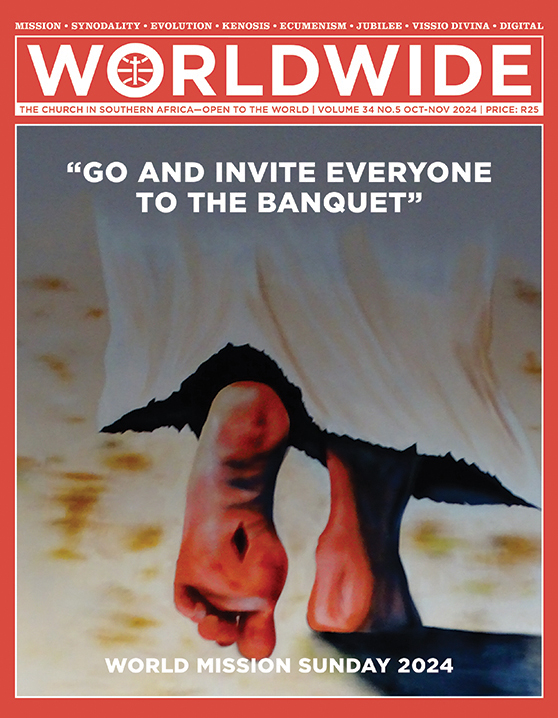
“GO AND INVITE EVERYONE TO THE BANQUET”
The image represents the feet of the Risen Jesus, in motion, showing the wounds of his Passion, yet ready to reach out and invite all to the banquet of his mercy. Likewise, Jesus invites to us to his mission in co-responsibility to bear witness to the power of his resurrection and to bring Jesus’ message of peace and fraternity to the whole world.
FEATURES • SYNOD ON SYNODALITY
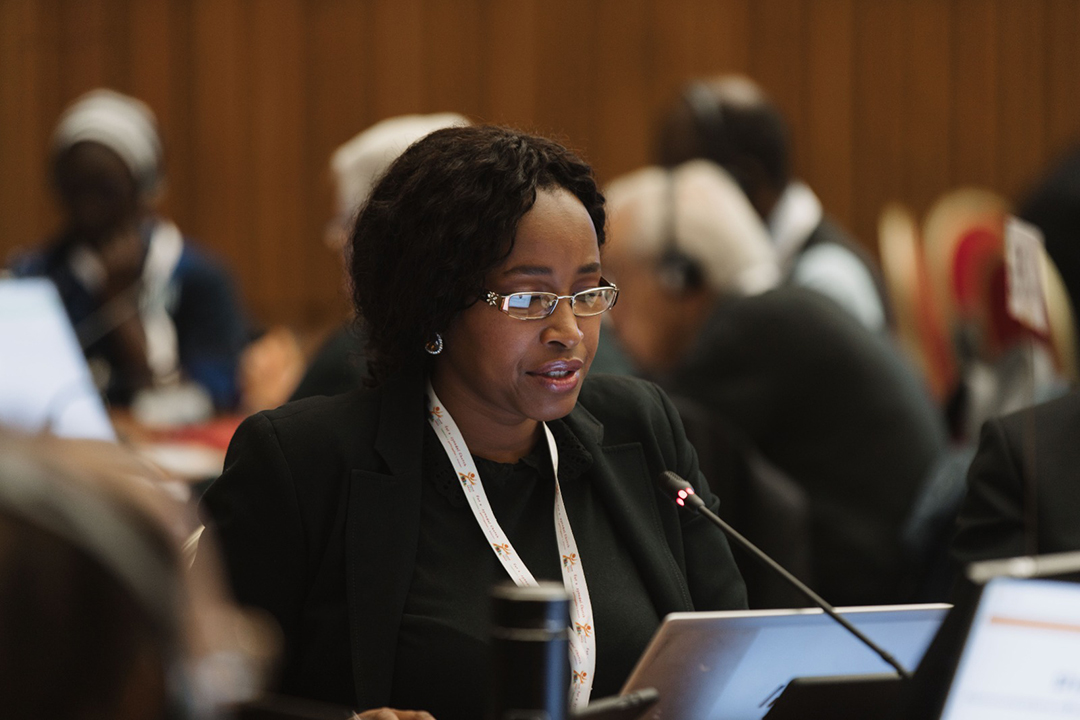
CO-RESPONSIBILITY, THE CALL OF THE SYNOD
Sheila Leocádia Pires is the SACBC Communications Officer and Secretary for the Synod Commission for Information. She shares her impressions with Worldwide, shortly before leaving for Rome to attend the Synod’s second session.
BY FR RAFAEL ARMADA MCCJ
Sheila, how did your nomination for the Synod come about?
It came as an absolute surprise. SECAM (Symposium of Episcopal Conferences of Africa and Madagascar) submitted my name, along with others, to Rome, to be part of the communication team of the Synod. I did not think much about it, nor did I expect to be chosen, although I had already participated in the meeting of the continental Synod communication team in Addis Ababa. When they informed me that Pope Francis had elected me as Secretary of the Commission, I was shocked. It was how I imagine a priest feels when told that he has been appointed bishop.
I guess the first session was an enriching experience…
Absolutely. I learnt a lot about the Catholic Church, about communication, and about the Synod itself. The three-day retreat prior to the official opening helped us enter the Conversations in the Spirit. Fr. Radcliffe and Sr. Angelini opened our minds and warned us that participants would most likely express opposite views; some would want to stick to old ways, while others would be open to new horizons. The Conversations in the Spirit are about this: mutual listening and respect, prayer, moments of silence, and reflection.
When the working phase started, we were placed in groups according to our themes of interest. In these groups, you would find cardinals, patriarchs, bishops, priests, lay people—young, married, or single. I chose topics less familiar to me and which embraced all categories of people, where I could not only learn, but also contribute my views. While most of the women grouped themselves according to issues about women, I was the only female in a group of cardinals, bishops, and archbishops. My first thought was: “Oh, Gosh, who is going to back me up?” Interestingly, we all shared freely, and it became such a beautiful conversation.
We enjoyed the simplicity and humbleness. In the Synod we are all equals. We listen and learn from each other. Everyone has something to contribute. For example, the Southern African Bishops’ Conference (SACBC) is ahead in terms of structures, compared to other parts of the world. We have Caritas, Migrants and Refugees’ Offices, Justice, Peace and Integrity of Creation Commissions, the Denis Hurley Peace Institute, and AIDS offices. We enjoyed a beautiful sharing of experiences from our respective Conferences and continents.
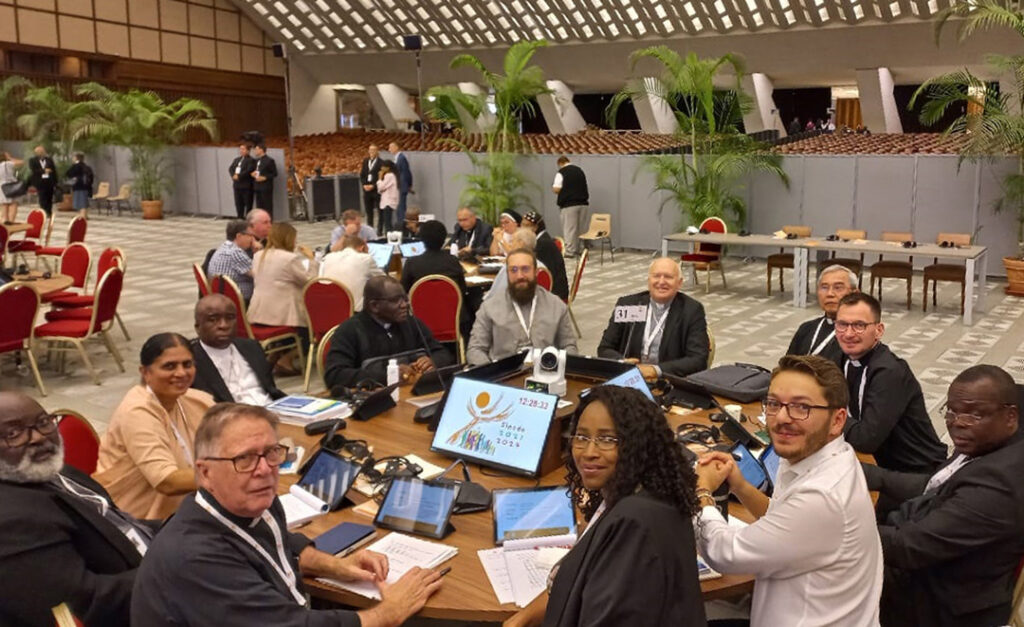
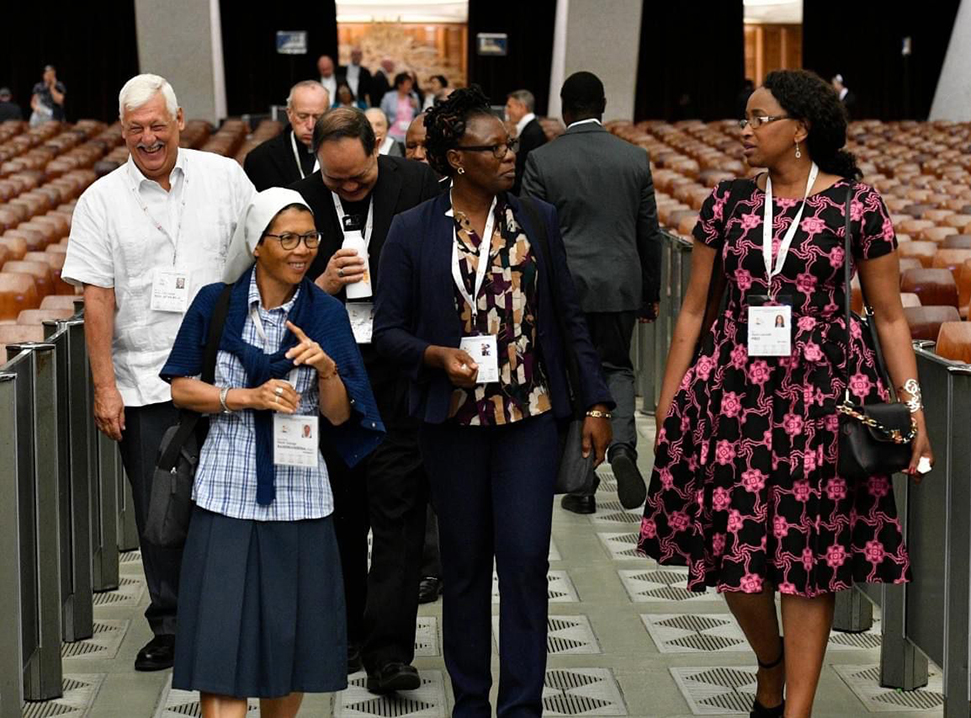
What picture was emerging in your mind about the current situation of the Church?
I strongly believe that the Church is moving in the right direction. In Africa, considered one of her lungs, the Church is growing; in Latin America and Asia, she is also expanding and communities are very active. Pope Francis is visiting churches on the periphery, such as in Papua New Guinea and East Timor. The faith in these vibrant nations has already been enculturated.
Many Conferences make use of social media to spread the gospel in a digital era, tapping new territories. It is no longer the same old Church in its old buildings. We are going beyond that, reaching out to communities online. We are also trying to attract young people. In the SACBC and other parts of Africa, the youth are committed on social media, evangelizing by means of different and creative ways. I do not see a Church declining, as others may find when looking at places like the USA or parts of Europe, where incidents like sex scandals and abuse of minors have marked her. In other regions, the Church is growing and is alive, vibrant, and healthy. Through our sharing in the Synod, we exchanged ideas about how to help the Church recover in regions where there has been a decline. What works in the SACBC, for example, could be applied to the American Bishops Conference, in New Zealand, or Germany. At the end of the first session, we came up with a synthesis report which included all our contributions. Many Conferences have started implementing suggestions contained in this report.
What do you see as the Church’s main challenges in Africa and South Africa?
Firstly, the lack of vocations to priesthood and religious life in some parts of Africa. In countries like Nigeria, vocations are booming, but in the SACBC, this is a real challenge. Also, foreign missionaries, especially from other parts of Africa, experience difficulties obtaining working Visas for South Africa. Some rural areas have no priests on a Sunday. For Bishops, entrusted with the responsibility of spreading the Word of God and providing the Eucharist to the faithful, a lack of priests is a big concern.
I strongly believe that the Church is moving in the right direction.
Another challenge is family life: broken families, households led by single parents, and an increase in divorces. In the synthesis report, we pointed out the need to involve young people, lay women, and men in decision-making processes, even as consultative bodies. We still have a long journey ahead regarding these matters.
What is the role of women in the Church in Africa?
I have lived most of my life in South Africa, but I am also familiar with places such as my country of birth, Mozambique. Women, especially in the SACBC nations—Botswana, Eswatini, South Africa—are playing a significant role at almost all levels. They are very active leaders in Sodalities, at fund-raising, prayer, and regarding issues of family life, and so forth. However, I would like to see them involved in more prominent roles in Diocesan Pastoral Councils and at Bishops’ Conference level.
In other parts of Africa, the situation is different. Certainly, we need to take into account the different cultures, respect people’s views, and not inflict on them what we consider to be their liberation. However, there is nothing wrong with educating, informing, and having conversations about these matters.
If we want changes, we also need to have conversations with boys, give them space to talk, and educate them from a young age about respecting their female counterparts and their rights to equal opportunities and remuneration. We are still very far, in the Church and in society, in this regard—women who do the same or more work than men are not reimbursed accordingly. That is a sad reality.
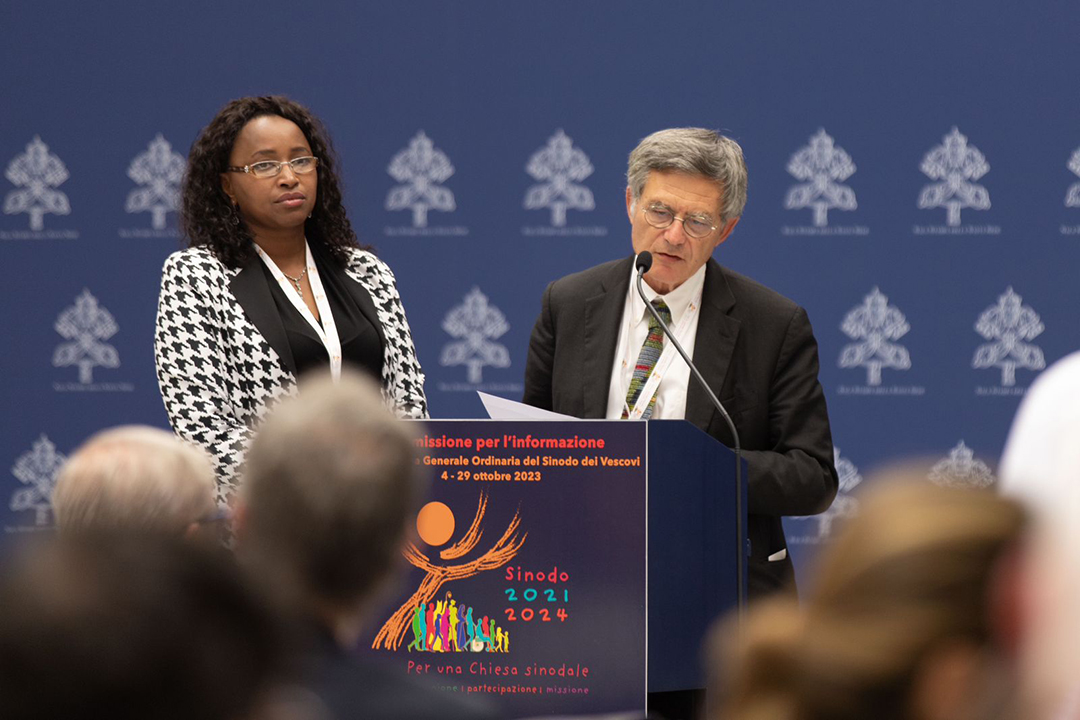
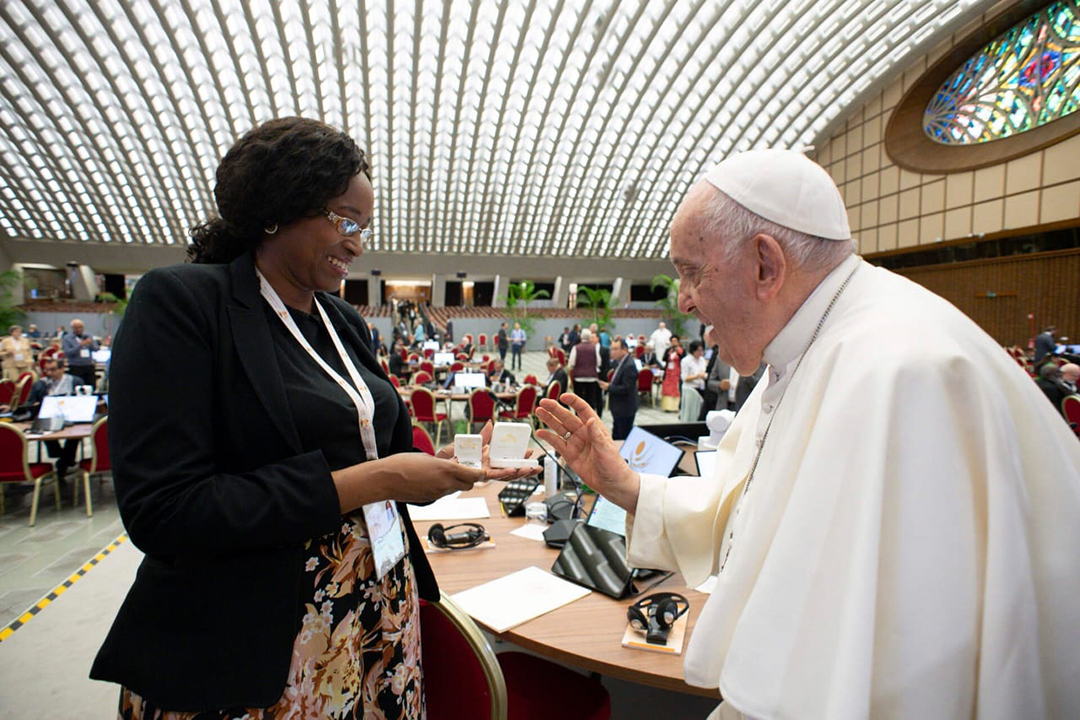
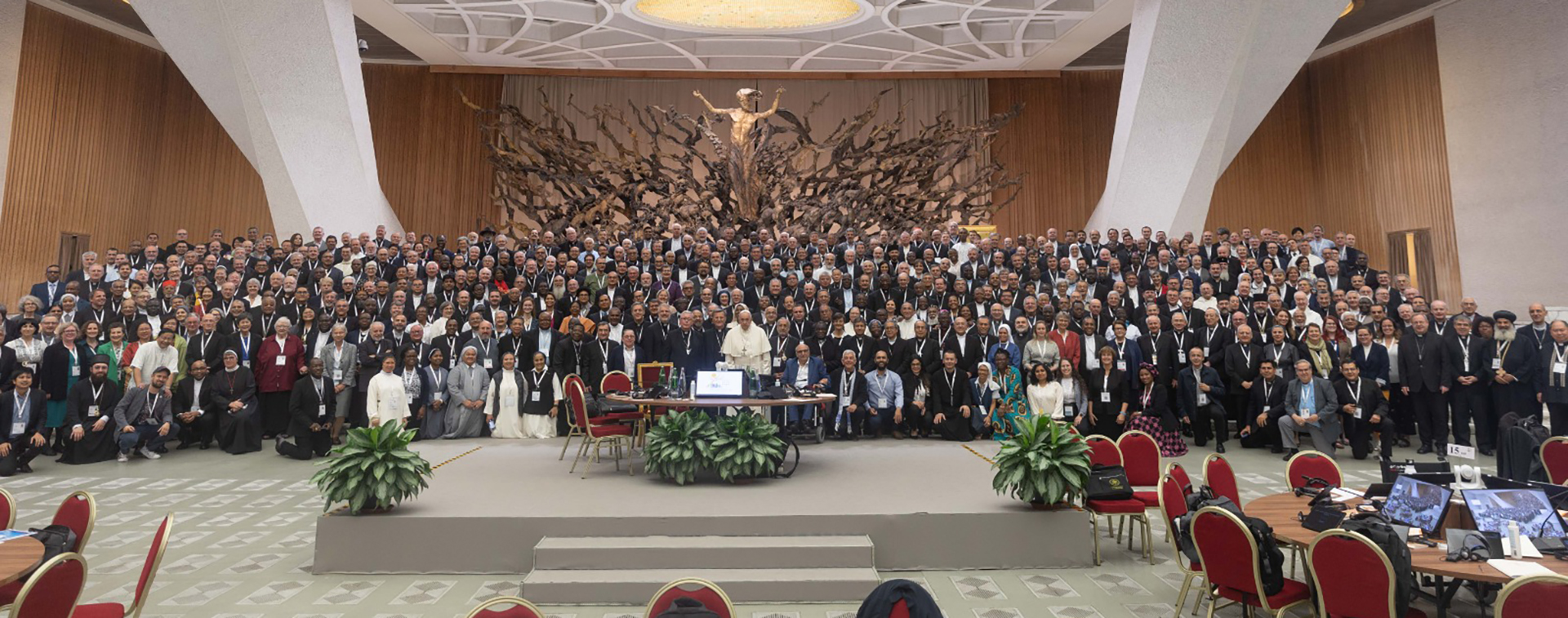
What feelings did women express in the Synod: a sense of being valued, being listened to, or, on the contrary, suppressed within the Church?
I perceived all those feelings. In certain places, women have more freedom than in others. For example, in Mozambique, women take leadership in catechesis, both in urban and rural areas, distributing communion to the sick and the elderly or leading the liturgy of the Word when there is no priest. In Brazil, for example, a national lay leader testified as to what women are doing there, which is similar to the situation in Southern Africa, where they are actively involved in the Church. Unfortunately, in other parts of the world, women are not allowed to exercise these ministries. Everyone shared their diverse realities.
What are your expectations for this second session?
I dream of a Church that listens more, is open to dialogue, and new ideas without infringing on her teachings or theology, thereby seeking new ways of being “Church.” The Synod teaches us about the importance of each one’s contribution and mutual co-responsibility. Priests need to facilitate teams where everyone’s talents are utilized in order for parishes to grow. Unfortunately, in some places, it is still ‘my way or the hard way.’
Since the end of the first session, from October last year until now, we have been looking at every topic of the synthesis report and the working document. This involves a lot of information, views, ideas, and suggestions…I am looking forward to a constructive way forward.
The Synod teaches us about the importance of each one’s contribution and mutual co-responsibility.
What about the involvement of women in the seminarians’ formation?
We had two workshops about it: one of IMBISA (Inter-Regional Meeting of the Bishops of Southern Africa) and another, a continental webinar. The participants, including formators and rectors, agreed on the importance of involving women in the formation of priests. In the SACBC, some religious sisters are part of the formation in the seminaries. Seminarians, as future priests, need to spend time in communities and engage with their different members, also involving parents in their formation.
Religious women are often not given the same opportunities for further studies as priests are; moreover, when a lay woman becomes a mother, she may encounter difficulties in studying and taking care of her family. We need to offer them training opportunities, maybe online, at parish or diocesan levels. If we want a flourishing Church, we need a better understanding of our faith. That can only be achieved if those in leadership create spaces for it.
How can the Church become more welcoming and inclusive?
We need frequent gatherings (izimbizo) to discuss issues. Some bishops meet the youth, without priests or Religious, with possibly only their chaplain present. In these encounters, young people can express themselves without fear of intimidation, which may occur when their parish priest, a sister, or their parents are present. They need those spaces of freedom. By creating opportunities for dialogue, the Church becomes more welcoming and inclusive. We also need moments for listening and prayer; opportunities for encounters for those who do not belong to any group: possibly divorcees, widows, single or teenage mothers who may feel ostracized. We welcome these groups by creating spaces where they are free and may speak openly, without feeling judged.
What was it like meeting Pope Francis?
As young people would say, Pope Francis is such a cool guy! He is friendly, warm, and welcoming. I really enjoyed having a few brief conversations with him. We talked about my uncle, the cardinal emeritus of Mozambique and, for many years, the bishop of Xai-Xai. Buenos Aires and Xai-Xai are sister dioceses, with priests from Xai-Xai sent to Buenos Aires for further studies. In my first conversation with Pope Francis, I introduced myself as the niece of Cardinal Xulio Langa. He responded: “Oh, the 85-year-old!” I was amazed by Pope Francis’ memory.
We also had a few informal conversations. I found him very easy-going and communicative. He absolutely loves to engage with people and have cordial conversations, not only about serious issues. He also cracks jokes. Once, when I asked him to autograph one of his books, he told me, “Make sure you read it.” “I will read it,” I replied, and he insisted, “Are you sure? Read it.” That’s Pope Francis. You fall in love with him, and you want to share more moments with him and learn from him. He is a very vibrant, warm, and loving person.
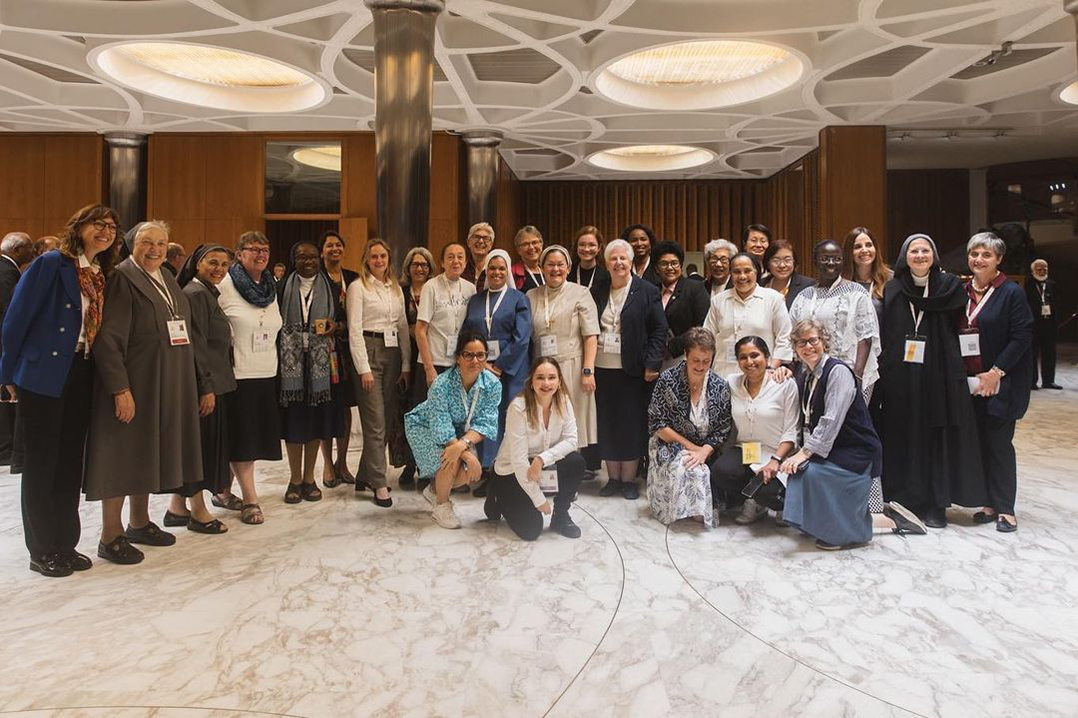
Your professional experience started at Radio Veritas before landing at the SACBC…
I never chose to be a radio presenter or a Catholic journalist—Catholic journalism chose me. I started at Radio Veritas 19 years ago as an assistant bookkeeper. One day, a presenter was absent, and I was asked to fill in. I found myself behind the microphone. I did that program, and from there, I started producing, writing news… I hosted the programs Holy Hour, Current Affairs, and others focused on women, youth, and boys.
I love my work as a Catholic journalist. I wish to make the Catholic Church more visible.
Since 2018, I have collaborated with Vatican News, profiling the Church and its departments. In secular media, I presented the program Good Morning, Africa for five years and interviewed high-profile figures from the entertainment and political spheres. It was a learning experience, and I tried to combine secular and Catholic media, drawing the best from both. I love my work as a Catholic journalist and wish to make the Catholic Church more visible.
Often, the secular media only talks about the Catholic Church when there is a scandal or controversial topic. Rarely do we hear good news about the Church. We can strengthen our own media by profiling the Church’s work. For example, the Church has education programs on human trafficking; the Justice and Peace Commission supports victims of human rights abuse; the Denis Hurley Institute focuses on war-torn regions like Cabo Delgado, Northern Mozambique, South Sudan, and the DRC.
When do we hear about these works in the secular media? The Church needs a strong communication arm to amplify her voice in Catholic media and share her information. For instance, what’s published in Worldwide magazine should be more visible. We must highlight these projects, such as Caritas’ work assisting the poor or the Office of Migrants and Refugees helping people gain vital documentation. The Catholic Institute of Education is another example.
There are countless stories never reported in the secular media. Therefore, we need a body that publicizes these efforts, informing Catholics and the wider public about the Church’s actions, including how she gives back to society.

